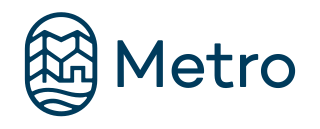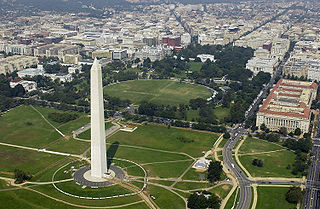Related Research Articles

The Metropolitan Council, commonly abbreviated Met Council or Metro Council, is the regional governmental agency and metropolitan planning organization in Minnesota serving the Twin Cities seven-county metropolitan area, accounting for over 55 percent of the state's population. It is one of two multi-county regional governments in the United States, the other being the Portland Metro.

The Washington–Baltimore metropolitan area is a combined statistical area consisting of the overlapping labor-market region of the cities of Washington, D.C., and Baltimore, Maryland. The region includes Central Maryland, Northern Virginia, three counties in the Eastern Panhandle of West Virginia, and one county in South Central Pennsylvania. It is the most educated, highest-income, and third-largest combined statistical area in the United States, behind only New York-Newark and Los Angeles-Long Beach.
Councils of governments are regional governing and/or coordinating bodies that exist throughout the United States. CoGs are normally controlled by their member local governments, though some states have passed laws granting CoGs region-wide powers over specific functions, and still other states mandate such councils.
Metro Transit is the primary public transportation operator in the Minneapolis–Saint Paul area of the U.S. state of Minnesota and the largest operator in the state. Although Metro Transit is one of the smallest transit systems for a large metropolitan area in the United States, it is ranked as one of the best. In 2021, the system had a ridership of 32,748,300, or about 93,500 per weekday as of the first quarter of 2022.
Metropolitan Washington Council of Governments (MWCOG) is an independent, nonprofit association where area leaders address regional issues affecting the District of Columbia, suburban Maryland and Northern Virginia. Metropolitan Washington Council of Governments comprises 24 local governments in the Washington metropolitan area, as well as area members of the Maryland and Virginia state legislatures, the U.S. Senate, and the U.S. House of Representatives. About 300 local, state and federal elected officials make up its membership. It was founded in 1957 and formally incorporated on May 28, 1965.

The Metro Green Line is an 11-mile (18 km) light rail line that connects the central business districts of Minneapolis and Saint Paul in Minnesota as well as the University of Minnesota. An extension is under construction that will extend the line to the southwest connecting St. Louis Park, Hopkins, Minnetonka and Eden Prairie. The line follows the path of former Metro Transit bus route 16 along University Avenue and Washington Avenue. It is the second light-rail line in the region, after the Blue Line, which opened in 2004 and connects Minneapolis with the southern suburb of Bloomington.

Metro is the regional government for the Oregon portion of the Portland metropolitan area, covering portions of Clackamas, Multnomah, and Washington Counties. It is the only directly elected regional government and metropolitan planning organization in the United States. Metro is responsible for overseeing the Portland region's solid waste system, general planning of land use and transportation, maintaining certain regional parks and natural areas, and operating the Oregon Zoo, Oregon Convention Center, Portland's Centers for the Arts, and the Portland Expo Center. It also distributes money from two voter-approved tax measures: one for homeless services and one for affordable housing.

Interstate 205 (I-205) is an auxiliary Interstate Highway in the Portland metropolitan area of Oregon and Washington, United States. The north–south freeway serves as a bypass route of I-5 along the east side of Portland, Oregon, and Vancouver, Washington. It intersects several major highways and serves Portland International Airport.
The Metropolitan Transportation Commission (MTC) is the government agency responsible for regional transportation planning and financing in the San Francisco Bay Area. It was created in 1970 by the State of California, with support from the Bay Area Council, to coordinate transportation services in the Bay Area's nine counties: Alameda, Contra Costa, Marin, Napa, San Francisco, San Mateo, Santa Clara, Solano, and Sonoma. The MTC is fourth most populous metropolitan planning organization in the United States.
Tri-state area is an informal term in the United States which can be used for any of several populated areas associated with a particular town or metropolis that, with adjacent suburbs, lies across three states. Some of these involve a state boundary tripoint. Other tri-state areas have a more diffuse population that shares a connected economy and geography—especially with respect to geology, botany, or climate. The term "tri-state area" is often present in radio and television commercials.

The Washington metropolitan area, also commonly referred to as the National Capital Region, is the metropolitan area centered on Washington, D.C., the capital of the United States. The area includes all of the District of Columbia and parts of the states of Maryland, Virginia and West Virginia. It is part of the larger Baltimore–Washington metropolitan area.

The Southwest LRT is an under–construction 14.5-mile (23.3 km) light rail transit corridor in Hennepin County, Minnesota, with service between Minneapolis and Eden Prairie. The estimated one-way travel time from Southwest Station in Eden Prairie to Target Field Station in Minneapolis is 32 minutes. The Southwest LRT will extend through St. Louis Park, Hopkins and Minnetonka along the route. Major locations on the line will include Bde Maka Ska, Cedar Lake, the Walker Art Center, the Minneapolis Sculpture Garden and Target Field in downtown Minneapolis.

State Highway 45 is a highway loop around Austin, Texas, that exists in two open segments. The official designation of SH 45 is such to form a complete loop around Austin, a distance of roughly 80 miles (130 km).
The METRO Purple Line, formerly known as the Rush Line Corridor, is a proposed bus rapid transit service that would run from Union Depot in downtown Saint Paul to the northeastern suburbs of Saint Paul. Along the corridor's 21 proposed stations there are 106,000 jobs within a 10-minute walk. The project is currently in an environmental analysis phase with further development, engineering, and construction expected to take at least six more years. Service would run 7-days a week with 10-minute headways in peak periods and 15-minute service at most other times. The corridor was named the Rush Line because it was originally planned to end in Rush City, Minnesota. After using the color purple since 2017, the route was officially named the Purple Line and became part of the METRO network on July 14, 2021.

The Denver Regional Council of Governments is a nonprofit, membership organization of local governments in the Denver region of the state of Colorado. DRCOG is the designated metropolitan planning organization (MPO) and the Transportation Planning Region (TPR) for the region, as well as the Area Agency on Aging (AAA).
The Chicago Metropolitan Agency for Planning (CMAP) is a metropolitan planning organization (MPO) responsible for comprehensive regional transportation planning in Cook, DuPage, Kane, Kendall, Lake, McHenry and Will counties in northeastern Illinois. The agency developed and now guides implementation of ON TO 2050, a new long-range plan to help the seven counties and 284 communities of northeastern Illinois implement strategies that address transportation, housing, economic development, open space, the environment, and other quality-of-life issues.
The Puget Sound Regional Council (PSRC) is a metropolitan planning organization that develops policies and makes decisions about transportation planning, economic development, and growth management throughout the four-county Seattle metropolitan area surrounding Puget Sound. It is a forum for cities, towns, counties, transit agencies, port districts, Native American tribes, and state agencies to address regional issues.

Joseph C. Szabo is a former government official who was the twelfth Federal Railroad Administrator of the United States. Nominated by President Barack Obama on March 20, 2009, he was confirmed by the United States Senate on April 29, 2009. Safety was the top priority of his administration. He stepped down from the position on January 9, 2015 and Sarah Feinberg became the Acting Administrator on January 12, 2015, and subsequently the permanent Administrator.

The District Department of Transportation is an agency of the government of the District of Columbia, in the United States, which manages and maintains publicly owned transportation infrastructure in the District of Columbia. DDOT is the lead agency with authority over the planning, design, construction, and maintenance of alleys, bridges, sidewalks, streets, street lights, and traffic signals in the District of Columbia.

Metro is a transit network in Minnesota serving the cities of Minneapolis and Saint Paul. It also provides service to some suburban areas. As of 2021 the system consists of two light rail lines and four bus transit lines all of which are operated by the local public transit company: Metro Transit. The five lines connect Downtown Minneapolis and St Paul with the Bloomington, Minneapolis-St Paul International Airport, Roseville, Richfield, Burnsville and Brooklyn Center.
References
- ↑ "Overview of RTC" (PDF). Southwest Washington Regional Transportation Council. Retrieved August 26, 2022.
- ↑ "Agency Overview". Southwest Washington Regional Transportation Council. Retrieved August 26, 2022.
- ↑ Florip, Eric (December 3, 2013). "Regional transportation council hires new executive director". The Columbian . Retrieved August 26, 2022.